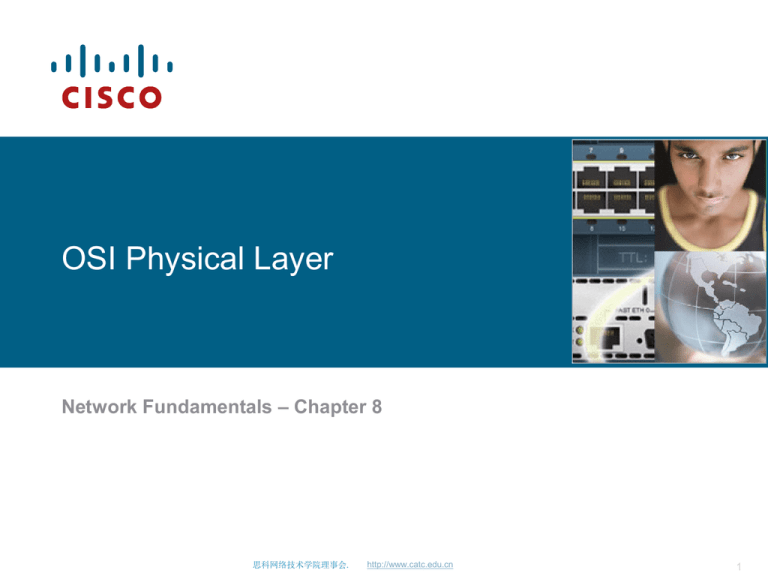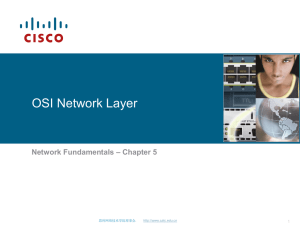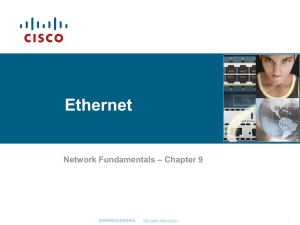OSI Physical Layer
advertisement

OSI Physical Layer Network Fundamentals – Chapter 8 思科网络技术学院理事会. http://www.catc.edu.cn 1 Objectives Explain the role of Physical layer protocols and services in supporting communication across data networks. - Describe the role of signals used to represent bits as a frame as the frame is transported across the local media Describe the purpose of Physical layer signaling and encoding as they are used in networks Identify the basic characteristics of copper, fiber and wireless network media Describe common uses of copper, fiber and wireless network media 思科网络技术学院理事会. http://www.catc.edu.cn 2 Context Index 8.1 The Physical Layer – Communication Signals 8.2 Physical Signaling and Encoding: Representing Bits 8.3 Physical Media – Connecting Communication 8.4 Labs – Media Connectors 思科网络技术学院理事会. http://www.catc.edu.cn 3 8.1 The Physical Layer – Communication Signals 思科网络技术学院理事会. http://www.catc.edu.cn 4 8.1.1 Physical Layer - Purpose The OSI Physical layer provides the means to transport across the network media the bits that make up a Data Link layer frame. 思科网络技术学院理事会. http://www.catc.edu.cn 5 8.1.1 Physical Layer - Purpose The purpose of the Physical layer is to create the electrical, optical, or microwave signal that represents the bits in each frame. 思科网络技术学院理事会. http://www.catc.edu.cn 6 8.1.2 Physical Layer - Operation There are three basic forms of network media on which data is represented: -Copper cable -Fiber -Wireless 思科网络技术学院理事会. http://www.catc.edu.cn 7 8.1.3 Physical Layer - Standards Comparison of Physical layer standards and upper layer standards 思科网络技术学院理事会. http://www.catc.edu.cn 8 8.1.3 Physical Layer - Standards Standards for the Physical layer specify signal, connector, and cabling requirements. 思科网络技术学院理事会. http://www.catc.edu.cn 9 8.1.3 Physical Layer - Standards Standards for the Physical layer specify signal, connector, and cabling requirements. 思科网络技术学院理事会. http://www.catc.edu.cn 10 8.1.3 Physical Layer - Standards Standards for the Physical layer specify signal, connector, and cabling requirements. 思科网络技术学院理事会. http://www.catc.edu.cn 11 8.1.3 Physical Layer - Standards Standards for the Physical layer specify signal, connector, and cabling requirements. 思科网络技术学院理事会. http://www.catc.edu.cn 12 8.1.4 Physical Layer Fundamental Principles The three fundamental functions of the Physical layer are: -The physical components -Data encoding -Signaling 思科网络技术学院理事会. http://www.catc.edu.cn 13 8.2 Physical Signaling and Encoding: Representing Bits 思科网络技术学院理事会. http://www.catc.edu.cn 14 8.2.1 Signaling Bits for the Media All communication from the human network becomes binary digits, which are transported individually across the physical media. Bits are represented on the medium by changing one or more of the following characteristics of a signal: -Amplitude -Frequency -Phase 思科网络技术学院理事会. http://www.catc.edu.cn 15 8.2.1 Signaling Bits for the Media Method of signaling: -Non Return to Zero (NRZ) Signaling -Manchester Encoding -4B/5B 思科网络技术学院理事会. http://www.catc.edu.cn 16 8.2.2 Encoding – Grouping Bits One way to provide frame detection is to begin each frame with a pattern of signals representing bits. 思科网络技术学院理事会. http://www.catc.edu.cn 17 8.2.2 Encoding – Grouping Bits A code group is a consecutive sequence of code bits that are interpreted and mapped as data bit patterns. Advantages using code groups include: -Reducing bit level error -Limiting energy transmitted -Distinguish data from control -Better media error detection 思科网络技术学院理事会. http://www.catc.edu.cn 18 8.2.3 Data carrying Capacity Data transfer can be measured in three ways: -Bandwidth -Throughput -Goodput Bandwidth Digital bandwidth measures the amount of information that can flow from one place to another in a given amount of time. 思科网络技术学院理事会. http://www.catc.edu.cn 19 8.2.3 Data carrying Capacity Data Throughput and Goodput 思科网络技术学院理事会. http://www.catc.edu.cn 20 8.3 Physical Media – Connecting Communication 思科网络技术学院理事会. http://www.catc.edu.cn 21 8.3.1 Types of Physical Media Several media characteristics defined by Physical layer standards. 思科网络技术学院理事会. http://www.catc.edu.cn 22 8.3.1 Types of Physical Media Several media characteristics defined by Physical layer standards. 思科网络技术学院理事会. http://www.catc.edu.cn 23 8.3.2 Copper Media The types of copper cabling include: -Coaxial cable -Twisted-pair cable · Unshielded Twisted-pair · Shielded Twisted-pair 思科网络技术学院理事会. http://www.catc.edu.cn 24 8.3.2 Copper Media External Signal Interference 思科网络技术学院理事会. http://www.catc.edu.cn 25 8.3.3 Unshielded Twisted Pair (UTP) Cable The basic characteristics of UTP cable 思科网络技术学院理事会. http://www.catc.edu.cn 26 8.3.3 Unshielded Twisted Pair (UTP) Cable UTP Cable Types -Ethernet Straight-through -Ethernet Crossover -Rollover 思科网络技术学院理事会. http://www.catc.edu.cn 27 8.3.4 Other Copper Cable Coaxial cable 思科网络技术学院理事会. http://www.catc.edu.cn 28 8.3.4 Other Copper Cable Coaxial cable 思科网络技术学院理事会. http://www.catc.edu.cn 29 8.3.4 Other Copper Cable Shielded Twisted-Pair (STP) Cable 思科网络技术学院理事会. http://www.catc.edu.cn 30 8.3.5 Copper Media Safety Types of safety issues when working with copper cabling 思科网络技术学院理事会. http://www.catc.edu.cn 31 8.3.6 Fiber Media Fiber Media Cable Construction 思科网络技术学院理事会. http://www.catc.edu.cn 32 8.3.6 Fiber Media Fiber Media Cable Construction 思科网络技术学院理事会. http://www.catc.edu.cn 33 8.3.6 Fiber Media Fiber provides full duplex communications with a cable dedicated to each direction. 思科网络技术学院理事会. http://www.catc.edu.cn 34 8.3.6 Fiber Media Fiber optic cables can be broadly classified into two types: single-mode and multimode. i 思科网络技术学院理事会. http://www.catc.edu.cn 35 8.2.7 Wireless Media Wireless media carry electromagnetic signals at radio and microwave frequencies that represent the binary digits of data communications. 思科网络技术学院理事会. http://www.catc.edu.cn 36 8.3.7 Wireless Media Types of Wireless Networks -Standard IEEE 802.11 -Standard IEEE 802.15 -Standard IEEE 802.16 -Global System for Mobile Communications (GSM) 思科网络技术学院理事会. http://www.catc.edu.cn 37 8.3.7 Wireless Media The Wireless LAN In general, a wireless LAN requires the following network devices: -Wireless Access Point (AP) -Wireless NIC adapters 思科网络技术学院理事会. http://www.catc.edu.cn 38 8.3.7 Wireless Media WLAN Ethernet-based standards include: IEEE 802.11a - Operates in the 5 GHz frequency band and offers speeds of up to 54 Mbps. IEEE 802.11b - Operates in the 2.4 GHz frequency band and offers speeds of up to 11 Mbps. IEEE 802.11g - Operates in the 2.4 GHz frequency band and offers speeds of up to 54 Mbps. IEEE 802.11n - The proposed standard defines frequency of 2.4 GHz or 5 GHz. The typical expected data rates are 100 Mbps to 210 Mbps with a distance range of up to 70 meters. 思科网络技术学院理事会. http://www.catc.edu.cn 39 8.3.8 Media Connectors Common Copper Media Connectors 思科网络技术学院理事会. http://www.catc.edu.cn 40 8.3.8 Media Connectors Correct Connector Termination 思科网络技术学院理事会. http://www.catc.edu.cn 41 8.3.8 Media Connectors Common Optical Fiber Connectors 思科网络技术学院理事会. http://www.catc.edu.cn 42 8.4 Labs – Media Connectors 思科网络技术学院理事会. http://www.catc.edu.cn 43 Category 5 UTP Cable Tests Lab 8.4.1: Media Connectors Lab Activity 思科网络技术学院理事会. http://www.catc.edu.cn 44 Summary 思科网络技术学院理事会. http://www.catc.edu.cn 45 思科网络技术学院理事会. http://www.catc.edu.cn 46










